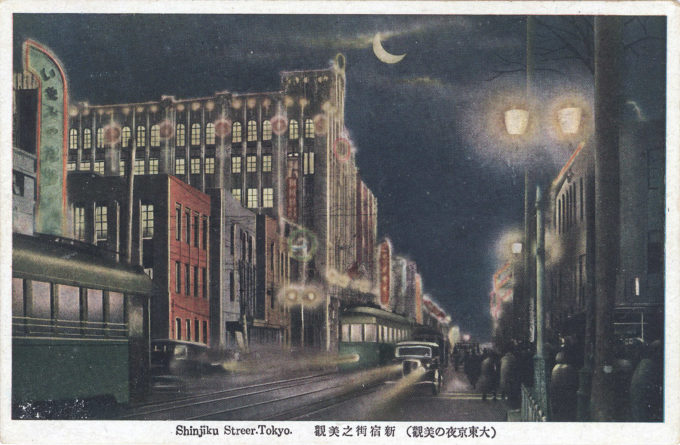“The rise of Shinjuku from a ramshackle village to the forefront as one of the business and pleasure centres of Tokyo is a living memory. In no other sections of the growing capital has the change been so spectacular as in Shinjuku.
“Shinjuku of twenty years ago, with its dusty roads alive with horses and wagons, and with open spaces devoted to no better purpose than to receiving waste paper and rotten vegetables, seems unreal in the light of its imposing sight to-day.”

Night view of Shinjuku, Tokyo, ca. 1940, looking east, with the boulevard busy with traffic and passersby crowding the sidewalk across from the Isetan department store at center.
See also:
Yodobashi (Shinjuku), Tokyo, c. 1910.
Shinjuku Station, Tokyo, c. 1930.
Isetan Department Store, Shinjuku, c. 1935.
Hoteiya department store, Shinjuku, Tokyo, 1929.
“In his sketches of Shinjuku, [Yu] Ryutanji offers some of his most provocative statements about what Tokyo might represent. Shinjuku was a neighborhood he felt exemplified everything that was becoming common in the ‘vortex of modern life,’ his catchphrase to describe the city. ‘Shinjuku Sketch’ (Shinjuku sukechi) was published in the April 1929 issue Kaizo, an issue that also featured Tokyo writings by Kawabata and Kon, articles on the women’s rights movement and the social position of art, and an evaluation of the magazine’s ten-year relationship with the literary establishment.
“Ryutanji uses the advancing consumer culture of Shinjuku to represent the idea of the metropolis at this moment in capitalist growth, manipulating language both to convey the bounty of the neighborhood and to expose its underlying paradoxes. In this sketch – which is less journalistic and more fragmented and full of experimental literary techniques that [Fumiko] Hayashi’s ‘One Hour in a Train Station’ or [Seiichi] Funahashi’s ‘Shinjuku Station’ – the first-person narrator, who calls himself the ‘author’ (hissha), talks directly to his readers in a friendly tone and sometimes addresses them in groups according to their interests.
“… As he leads his readers around Shinjuku from morning until night, he stops his verbal tour at moments and tells them to pay attention to particular sights and sounds that represent increasing routinization and monotony of urban daily life, on one hand, and the availability of leisure activities for the middle classes, on the other. Ryutanji acknowledges the integral role of mass transportation in these developments, and Shinjuku Station is the axis of both his verbal sketch and of the actual bustling terminal town around which all else is revolving.
“… Notably, the name ‘Shinjuku’ is not mentioned until after the description of the station and its human and vehicular traffic. The narrator-author explains that the western suburb of Shinjuku lies in the center of this web of mass transportation and that this important station (yoeki) is responsible for its development into a modern entertainment center.
“To prove this theory, he tells his readers to go and take a look where the streetcar tracks end in the western part of the neighborhood. There, rows of dilapidated houses and other vestiges of the ‘shadows of the city’ can be seen. The narrator expresses his surprise that the area near Shinjuku Station, where Edo prostitutes once lived, has become the center of metropolitan Tokyo.”
– Tokyo in Transit: Japanese Culture on the Road, by Alisa Freedman, 2010

